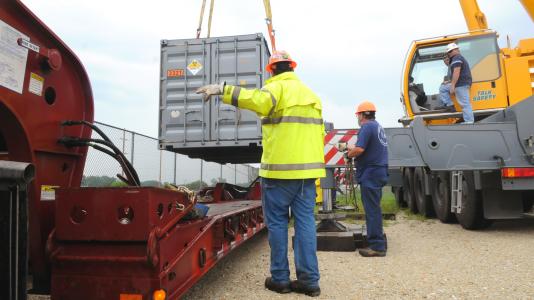
The device—called a shield plug—was used to seal and shield the Chicago Pile-5 reactor. CP-5 allowed for great strides in nuclear physics and materials research; it attracted scientists from across the world and served as a model for research reactors here and abroad. It was largely dismantled more than a decade ago after 25 years of use.
The shield plug has been in storage for more than 12 years; the laboratory was unable to remove it until its radiation levels fell below a certain threshold.
“This is an important step in removing legacy waste from our campus,” said Argonne Director Eric Isaacs. “It helps free up resources for science and engineering aimed at solving big national problems like developing green energy technologies.”
The shield plug was approximately 90 cubic feet in size and consisted of a half-inch thick stainless steel shell lined with three and a half inches of poured lead; it was filled with high-density concrete.
Scientists once put samples inside the plug so that they would be irradiated.
The device was shipped off-site earlier this month with the help of the Utah-based treatment and disposal company EnergySolutions.
Several Argonne divisions and groups—including Waste Management Operations, Central Shops, Facilities Management & Services—and Energy Solutions worked together to complete this project, which cost approximately $200,000. The money came from omnibus funding set aside for the treatment and disposal of legacy waste.
The plug was shipped on a heavy duty trailer inside a special box with a 7-inch thick steel bottom. The top was welded shut and placed inside an Industrial Package Type 2 container—which was designed specifically for this item—with an inch of steel all the way around.
“The waste managers who pulled this out in 1997 had a lot of forethought in terms of what they would need to do to safely store this item,” said project manager Chris Brandjes.
He said they placed the plug in a Type A Cask and then placed the cask on a two-inch thick steel plate, which provided a significant amount of shielding.
“So you have this robust Type A Cask with four inches of steel all around, plus the two-inch thick steel plate it was sitting on,” Brandjes said. “It was a very safe way to store the plug until it could be moved off site.”
Brandjes said there was no removable contamination associated with the plug. Once it was placed inside the Type A Cask, there was only negligible radiation outside the cask.
The plug and its container were taken to EnergySolution’s treatment and disposal facility in Clive, Utah, where the plug will be encased in concrete and then buried.